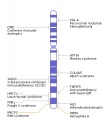File:Fragile X protein cartoon.jpg: Difference between revisions
(===Nuclear Fragile X Mental Retardation Protein is localized to Cajal bodies=== PLoS Genet. 2013 Oct;9(10):e1003890. doi: 10.1371/journal.pgen.1003890. Epub 2013 Oct 31. Dury AY1, El Fatimy R, Tremblay S, Rose TM, Côté J, De Koninck P, Khandjian EW....) |
mNo edit summary |
||
| (9 intermediate revisions by the same user not shown) | |||
| Line 1: | Line 1: | ||
== | ==Fragile X Protein Model== | ||
Alternative splicing of the primary transcripts generates either ISO6 FMRP lacking the CRD domain, or ISO1 FMRP containing both NLS and CRD domains. | |||
ISO6 is driven to Cajal bodies by transporter proteins, while ISO1 interacts with protein partners that lock the NLS and CRD domains and is localized to the perinuclear area to join the nascent mRNPs complexes emerging from the nuclear pores. | |||
In the cytoplasm the ISO1 FMRP-mRNPs particles associate with the translation machinery or are transported in RNA-granules to micro-domains away from the soma. | |||
:'''Links:''' [[:File:Fragile_X_protein_ISO6_and_Cajal_bodies.jpg|Image - FMRP and Cahal bodies]] | [[:File:Fragile X protein cartoon.jpg|FMRP model]] | [[Fragile X Syndrome]] | [[Embryology_History_-_Santiago_Ramón_y_Cajal|Cajal]] | |||
<br> | |||
<br> | |||
{{X Chromosome Links}} | |||
===Reference=== | ===Reference=== | ||
{{#pmid:24204304}} | |||
====Copyright==== | ====Copyright==== | ||
© 2013 Dury et al. This is an open-access article distributed under the terms of the Creative Commons Attribution License, which permits unrestricted use, distribution, and reproduction in any medium, provided the original author and source are credited. | © 2013 Dury et al. This is an open-access article distributed under the terms of the Creative Commons Attribution License, which permits unrestricted use, distribution, and reproduction in any medium, provided the original author and source are credited. | ||
Figure 10 doi:10.1371/journal.pgen.1003890.g010 panel B cropped from full figure. Resized and relabelled. | |||
{{Footer}} | |||
[[Category:Fragile X Syndrome]][[Category:Cartoon]][[Category:X Chromosome]] | |||
Latest revision as of 10:29, 20 March 2018
Fragile X Protein Model
Alternative splicing of the primary transcripts generates either ISO6 FMRP lacking the CRD domain, or ISO1 FMRP containing both NLS and CRD domains.
ISO6 is driven to Cajal bodies by transporter proteins, while ISO1 interacts with protein partners that lock the NLS and CRD domains and is localized to the perinuclear area to join the nascent mRNPs complexes emerging from the nuclear pores.
In the cytoplasm the ISO1 FMRP-mRNPs particles associate with the translation machinery or are transported in RNA-granules to micro-domains away from the soma.
- Links: Image - FMRP and Cahal bodies | FMRP model | Fragile X Syndrome | Cajal
Reference
Dury AY, El Fatimy R, Tremblay S, Rose TM, Côté J, De Koninck P & Khandjian EW. (2013). Nuclear Fragile X Mental Retardation Protein is localized to Cajal bodies. PLoS Genet. , 9, e1003890. PMID: 24204304 DOI.
Copyright
© 2013 Dury et al. This is an open-access article distributed under the terms of the Creative Commons Attribution License, which permits unrestricted use, distribution, and reproduction in any medium, provided the original author and source are credited.
Figure 10 doi:10.1371/journal.pgen.1003890.g010 panel B cropped from full figure. Resized and relabelled.
Cite this page: Hill, M.A. (2024, June 25) Embryology Fragile X protein cartoon.jpg. Retrieved from https://embryology.med.unsw.edu.au/embryology/index.php/File:Fragile_X_protein_cartoon.jpg
- © Dr Mark Hill 2024, UNSW Embryology ISBN: 978 0 7334 2609 4 - UNSW CRICOS Provider Code No. 00098G
File history
Yi efo/eka'e gwa ebo wo le nyangagi wuncin ye kamina wunga tinya nan
| Gwalagizhi | Nyangagi | Dimensions | User | Comment | |
|---|---|---|---|---|---|
| current | 10:05, 15 August 2014 |  | 1,000 × 615 (107 KB) | Z8600021 (talk | contribs) | ===Nuclear Fragile X Mental Retardation Protein is localized to Cajal bodies=== PLoS Genet. 2013 Oct;9(10):e1003890. doi: 10.1371/journal.pgen.1003890. Epub 2013 Oct 31. Dury AY1, El Fatimy R, Tremblay S, Rose TM, Côté J, De Koninck P, Khandjian EW.... |
You cannot overwrite this file.
File usage
The following 9 pages use this file:




